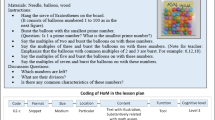Abstract
This chapter explores the development and student uptake of a five-year-old course in “History of Mathematics for Teachers” as part of a secondary teacher education program. In the design of this 13-week course, choices had to be made about which aspects, eras and cultures’ history of mathematics to include, what pedagogies to use to engage future secondary teachers with math history in meaningful ways, what the ‘big picture’ message(s) and take-aways might be from this course (i.e., the pedagogical intentions of the course), which resources could be drawn on to bring these intentions to reality. Once the instructor had made these design decisions, and made a series of mid-course adjustments to adapt to student requests and suggestions, there remains the question of student uptake of these intentions and design decisions. Were the intentions understood by learners, and were they effective in promoting an attention to historic consciousness, diversity in many dimensions, and to supporting new teachers’ flexible thinking and design approaches for their own teaching? Course syllabi, blog posts and student writing are used to explore these questions in presenting this particular course as a case study for further work on inclusion of the history of mathematics for diversity in teacher education.
Access this chapter
Tax calculation will be finalised at checkout
Purchases are for personal use only
Similar content being viewed by others
References
Aaboe, A. (1963). Episodes from the early history of mathematics. Mathematical Association of America. ISBN: 0-88385-613-1.
BBC. (1993). Fermat’s Last Theorem - The theorem and its proof. Film retrieved May 2022 from <https://www.youtube.com/watch?v=6ymTZEeTjI8>
Berggren, J. L. (2017). Episodes in the mathematics of medieval Islam. Springer. ISBN 978-1493937783.
Byrne, O. (1847/2022). The first six books of the elements of Euclid: In which coloured diagrams and symbols are used instead of letters for the greater ease of learners. Taschen. ISBN: 978-3836577380.
Doolittle, E. (2007). Mathematics as medicine. In Liljedahl, P. (Ed.) Proceedings of the 2006 Annual Meeting of the Canadian mathematics education study group (30th, Calgary, Alberta, Canada, Jun 3-7, 2006). Canadian Mathematics Education Study Group. Retrieved May 2022 from < https://eric.ed.gov/?id=ED529562>
Gerofsky, S. (2004). A man left Albuquerque heading east: Word problems as genre in mathematics education. Peter Lang. ISBN: 978-0820458236.
Gerofsky, S. (2008). Mathematics education. In S. Mathison & W. Ross (Eds.), Battleground schools. : Greenwood, vol. 2, pp. 391–400. ISBN: 978-0313339424.
Gerofsky, S. (2019). Approaching the history of mathematics via the performing arts: Kepler: A “renaissance folk play” in verse. The Mathematical Intelligencer, 41, 57–66.
Gustafson, R. (2012). Was Pythagoras Chinese? Revisiting an old debate. The Mathematics Enthusiast, 9(1), Article 10. Retrieved May 2022 from <http://scholarworks.umt.edu/tme/vol9/iss1/10>
Hadley, J., & Singmaster, D. (1992). Problems to sharpen the young. The Mathematical Gazette, 76(475), 102–126.
Heath, T. L. (Ed.). (1956). The thirteen books of Euclid’s elements. Dover. ISBN 978-0486600888.
Iseke-Barnes, J. M. (2000). Ethnomathematics and language in decolonizing mathematics. Race, Gender & Class, 7(3), 133–149.
Joseph, G. G. (1999). The crest of the peacock: Non-European roots of mathematics. Princeton University Press.
Major, A. (2017). Numbers with personality. In D. Swart, C. Séquin, & K. Fenyvesi (Eds.), Proceedings of bridges 2017: Mathematics, art, music, architecture, education, culture. Retrieved May 2022 from <https://archive.bridgesmathart.org/2017/bridges2017-1.html>
O’Shea, T. (2016). Mathematics education across time and place: Over two millennia from Athens to Zimbabwe. FriesenPress. ISBN 978-1460286081.
Pape, S. J., & Tchoshanov, M. A. (2001). The role of representation(s) in developing mathematical understanding. Theory Into Practice, 40(2), 118–127.
Schrader, D. V. (1967). The arithmetic of the medieval universities. The Mathematics Teacher, 60(3), 264–278.
Scott, D. (2006). Plato’s Meno. Cambridge University Press.
Scriba, C. J., & Schreiber, P. (2010). 5000 years of geometry: Mathematics in history and culture. Springer. ISBN: 978-3-0348-0898-9.
Shell-Gellasch, A. (Ed.). (2008). Hands-on history: A resource for teaching mathematics. Mathematical Association of America.
TRC (Truth and Reconciliation Commission). (2015–2022). Reports of the Canadian Truth and Reconciliation Commission. Retrieved May 2022 from <https://nctr.ca/records/reports/>
Tzanakis, C., Arcavi, A., Sa, C. C. D., Isoda, M., Lit, C. K., Niss, M., de Carvalho, J. P., Rodriguez, M., & Siu, M. K. (2002). Integrating history of mathematics in the classroom: An analytic survey. In History in mathematics education (pp. 201–240). Springer.
Author information
Authors and Affiliations
Corresponding author
Editor information
Editors and Affiliations
Rights and permissions
Copyright information
© 2023 The Author(s), under exclusive license to Springer Nature Switzerland AG
About this chapter
Cite this chapter
Gerofsky, S. (2023). The Potential in Teaching the History of Mathematics to Pre-service Secondary School Teachers. In: Romero Sanchez, S., Serradó Bayés, A., Appelbaum, P., Aldon, G. (eds) The Role of the History of Mathematics in the Teaching/Learning Process. Advances in Mathematics Education. Springer, Cham. https://doi.org/10.1007/978-3-031-29900-1_10
Download citation
DOI: https://doi.org/10.1007/978-3-031-29900-1_10
Published:
Publisher Name: Springer, Cham
Print ISBN: 978-3-031-29899-8
Online ISBN: 978-3-031-29900-1
eBook Packages: EducationEducation (R0)




